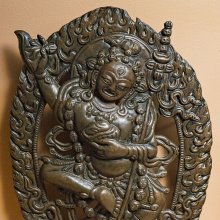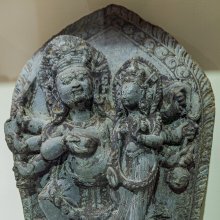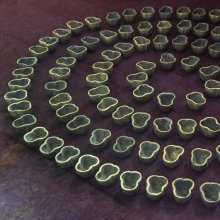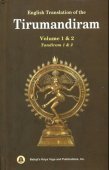Skull: 3 definitions
Introduction:
Skull means something in Hinduism, Sanskrit. If you want to know the exact meaning, history, etymology or English translation of this term then check out the descriptions on this page. Add your comment or reference to a book if you want to contribute to this summary article.
Images (photo gallery)
(+41 more images available)
In Hinduism
Shaivism (Shaiva philosophy)
Source: Brill: Śaivism and the Tantric TraditionsThe Skull (Sanskrit: kapāla) refers to the most conspicuous attribute of the Kāpālikas (“Skull-bearers”), who were perhaps the most notorious Śaiva ascetics of classical India. They were known for their cremation ground rituals and for wandering around with a skull for an alms bowl. The skull (kapāla), their most conspicuous attribute, also provided their name.

Shaiva (शैव, śaiva) or Shaivism (śaivism) represents a tradition of Hinduism worshiping Shiva as the supreme being. Closely related to Shaktism, Shaiva literature includes a range of scriptures, including Tantras, while the root of this tradition may be traced back to the ancient Vedas.
Yoga (school of philosophy)
Source: ORA: Amanaska (king of all yogas): A Critical Edition and Annotated Translation by Jason BirchSkulls are denoted by the Sanskrit term Kapāla, according to the Amanaska Yoga treatise dealing with meditation, absorption, yogic powers and liberation.—Accordingly, as Īśvara says to Vāmadeva: “[...] Putting on ochre garments, carrying a skull (kapāla), plucking out clumps of hair, maintaining non-vedic religious observances, ashes, ascetic clothing and matted locks, behaving as if mad, [the ascetic practice of] nakedness, [studying] the Vedas, Tantras and so on and the meeting [of learned people] for [reciting] poetry in the assembly: All [this] is exertion for the sake of filling one's stomach and is not the cause of the highest good. [...]”.

Yoga is originally considered a branch of Hindu philosophy (astika), but both ancient and modern Yoga combine the physical, mental and spiritual. Yoga teaches various physical techniques also known as āsanas (postures), used for various purposes (eg., meditation, contemplation, relaxation).
Shaktism (Shakta philosophy)
Source: ORA: Amanaska (king of all yogas): (shaktism)The Skull is denoted by the Sanskrit term Kapāla, according to the 17th century Kaulagajamardana (“crushing the Kaula elephant”) authored by Kāśīnātha or Kṛṣṇānandācala.—Accordingly, [as Īśvara said to Pārvatī]: “[...] [Now,] my dear, hear about the Kāpālika. He eats from a skull bowl (kapāla-pātra) and is addicted to wine and flesh; he neglects the disciplines of purification and he is adorned with a bald head and Mālās; he eats from the fires of the cremation ground; he alone is a Kāpālika, he never does [the proper] repetition of Mantras, nor ascetic practices nor [follows] the rules of personal restraint. He is without such [rituals] as bathing and ceremonies for donation. [Thus,] he is proclaimed a Pāṣānḍa. [...]”

Shakta (शाक्त, śākta) or Shaktism (śāktism) represents a tradition of Hinduism where the Goddess (Devi) is revered and worshipped. Shakta literature includes a range of scriptures, including various Agamas and Tantras, although its roots may be traced back to the Vedas.
See also (Relevant definitions)
Starts with: Skull bowl, Skull-bearer, Skullcap-like coleus.
Full-text (+1964): Kapala, Khatvanga, Kapalin, Kapalika, Kapaladhara, Naramala, Karoti, Mastaka, Karota, Karanka, Kapalamalin, Mundamala, Kapalamala, Kapikanduka, Kapalabhrit, Rundamala, Shirshaka, Bhagala, Bhagalin, Narati.
Relevant text
Search found 157 books and stories containing Skull; (plurals include: Skulls). You can also click to the full overview containing English textual excerpts. Below are direct links for the most relevant articles:
The Religion and Philosophy of Tevaram (Thevaram) (by M. A. Dorai Rangaswamy)
Symbology of the skull in the Mahavrata < [Volume 2 - Nampi Arurar and Mythology]
Symbology of bones in the Mahavrata < [Volume 2 - Nampi Arurar and Mythology]
The various sects of Shaivism < [Volume 2 - Nampi Arurar and Mythology]
The Skanda Purana (by G. V. Tagare)
Chapter 8 - Kapāleśvara (kapāla-īśvara-liṅga) < [Section 2 - Caturaśīti-liṅga-māhātmya]
Chapter 103 - Greatness of Kapāleśvara (Kapāla-īśvara) < [Section 1 - Prabhāsa-kṣetra-māhātmya]
Chapter 182 - The Yajña of Brahmā: The First Day < [Section 1 - Tīrtha-māhātmya]
Dhammapada (Illustrated) (by Ven. Weagoda Sarada Maha Thero)
Verse 419-420 - The Story of the Skull-Tapper < [Chapter 26 - Brāhmaṇa Vagga (The Brāhmaṇa)]
Verse 149 - The Story of Adhimānika Monks < [Chapter 11 - Jarā Vagga (Old Age)]
Garga Samhita (English) (by Danavir Goswami)
Verse 6.1.31 < [Chapter 1 - Jarāsandha’s Defeat]
Verse 4.9.14 < [Chapter 9 - The Glories of Srī Ekādaśī]
Verse 3.2.13 < [Chapter 2 - The Great Festival of Śrī Girirāja]
Guhyagarbha Tantra (with Commentary) (by Gyurme Dorje)
Text 17.6 (Commentary) < [Chapter 17 (Text And Commentary)]
Text 8.16 (Commentary) < [Chapter 8 (text and commentary)]
Chapter 17 - Revelation of the Maṇḍala of Wrathful Deities < [Chapter 17 (Text And Commentary)]
The Great Chariot (by Longchenpa)
Part 4 - The particular details < [E. Knowing what is to be abandoned and accepted, and how the siddhis are received]
Part 3d.2c - The perfect teacher < [B. The explanation of the kayas and wisdoms]
Part 4a.4 - The great mandala of the environment and inhabitants < [B. The explanation of meditation practice]
Related products






